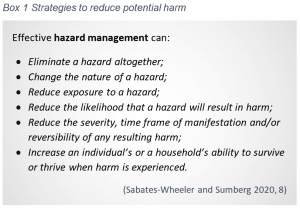Over the past twenty years, much work has been dedicated to improving labour standards in cocoa production, with the aim of weeding out child labour. Nevertheless, the latest survey of child labour in cocoa in Côte d’Ivoire and Ghana, comparing data from 2008/09, 2013/14 and 2018/19, shows no significant reduction in the overall prevalence of children working longer hours than permitted or doing hazardous work. While policy and industry actors ponder strategies to make cocoa production and consumption more ethical, there is still a long way to go. This blog delves into the survey report to shine a light on changes hidden beneath the regional findings, and in doing so reflects on how these changes sit with orthodox ideas about harmful work and children’s rights.
The United Nations have declared 2021 the International Year for the Elimination of Child Labour, with the International Labour Organization (ILO) at the helm of implementing change through its IPEC+ flagship programme. Not all work that children do is considered child labour; the distinction between work that is considered benign and that which is considered potentially harmful hinges on a child’s age and the specific tasks undertaken. ILO standards assert that children aged 11 years and younger should not work, children aged 12-14 years can do light work (less than 14 hours per week) and children aged 15-17 years can work up to 43 hours per week, as long as the work does not hamper their education or physical and mental well-being and does not involve tasks considered to be hazardous. While these standards may seem straight-forward, the framing of child labour and hazardous work remains simplistic and far removed from rural realities.
Child labour and standards regulating the hours worked
As a point of departure, it is vital to recognise that in West Africa children’s work is the norm, and not a deviation. The survey, undertaken in Côte d’Ivoire and Ghana by the National Opinion Research Center (NORC) at the University of Chicago, estimates that in 2018/19 around 80 percent of children aged 5-17 years in cocoa growing areas were economically active, having worked at least one hour in any type of work, paid or unpaid, in the past twelve months (p. 55-56). However, the conditions under which such work takes place need unpacking to truly understand the pressures that children may come under regarding the hours they work, the tasks they do, and the frequency and seasonality of their work. These are all critical factors in assessing the hazards and potential harm to children’s immediate and future well-being.
A closer reading of the NORC survey report reveals that, except for the 5-11-year-olds who are not supposed to work, the majority of children worked much less in cocoa than the hours permitted for their age cohort in both 2008/09 and 2018/19 (p. 179). Scrutinizing the data from those children who worked more, national differences emerged. For example, in Côte d’Ivoire, the proportion of boys and girls aged 5-11 years and 12-14 years who were exposed to child labour increased. However, this was significantly more so among boys – the prevalence rose from 13 percent of the 5-11-year-old boys in 2008/09 to 24 percent in 2018/19 and from 15 percent of the 12-14-year-old boys to 26 percent in the same period. In Ghana, the proportion of the youngest cohort exposed to child labour rose slightly among boys but more significantly among girls, rising from 21 percent in 2008/09 to 32 percent in 2018/19. For the older cohorts, the proportion of boys and girls exceeding the permitted working hours fell slightly. At a first glance, the effect of programming on the proportion of children exposed to child labour seems negligible. However, a closer analysis of the average hours worked per week indicates a decreasing trend across all age groups for both boys and girls, implying that although more children exceeded the permitted working hours in 2018/19, they were likely to work less than a decade earlier.
Whether the hours worked is an adequate indicator of potential harm also needs careful consideration. Firstly, children aged 5-11 years often accompany parents to the farm if they are not in school because it is not considered safe to leave them on their own at home. Children in this age group are encouraged to learn the tasks involved in their family’s livelihood portfolio but they are only gradually obliged to work. Farm work also has a social dimension and children participate in the chats, banter and social life, particularly when working in groups with neighbours and relatives.[1] Secondly, in addition to working with their parents, the older cohorts may also work for other relatives who support their schooling, or undertake casual labour. The relationship with the farmer is likely to affect the intensity of the work due to the effort invested by the child and the expectations the farmer has of the children working with him/her.
An assessment of potential harm linked to the hours that children work therefore requires a more elaborate – and thus more costly – set of data that considers temporal aspects of their work related to seasonality, the timing of their labour inputs (e.g., school day vs non-school day) and the severity of exposure. There is also a need to see children’s work in its broader context. While much international attention has focused on the eliminating child labour from the cocoa supply chain, it is important to bear in mind that children also work in other agricultural activities as well as in off-farm activities. A narrow focus on one part of their livelihood portfolios is thus insufficient from a child protection perspective.
Unpacking hazardous work
The concept of hazardous work is diverse in interpretation and often fuzzy. International standards, for example, define hazardous work to include heavy work relating to land clearing and transportation, exposure to agro-chemicals, the use of sharp tools, long working hours, and night work. But the standards set out in national legislations differ. In Ghana, for example, additional standards consider the impact of work on children’s schooling and their social life.[2] In Côte d’Ivoire, hazardous work includes the absence of a day to rest and participation in charcoal production.[3]
The NORC survey highlights that the proportion of children who were exposed to multiple hazardous activities in cocoa production rose significantly between 2008/09 and 2018/19. In Côte d’Ivoire, 46 percent of boys and 27 percent of girls aged 5-17 years were exposed to multiple hazardous activities, suggesting an increase of 20 percent and 8 percent, respectively. In Ghana, the proportion of boys exposed to multiple hazards increased by 9 percent to 57 percent in 2018/19, while the proportion of girls increased by 8 percent to 45 percent. Data from both countries indicate that more boys are involved in cocoa production than girls (p. 186).
Disaggregating the data further to look at individual tasks reveals that the proportion of children exposed to agro-chemicals has risen drastically. This is not because this work has been shifted over to children, but because the use of agro-chemicals has escalated. In the NORC survey, exposure to agro-chemicals is recorded if a child participates in the spraying or preparation and cleaning of equipment, if they carry water for spraying, if they are present or work in the vicinity of a farm during spraying, or if they re-enter a sprayed farm within less than 12 hours of spraying (p. 33-34).
The type of work children undertake is closely associated with local notions of gender and age-appropriate work. Girls and the youngest cohort of children are predominantly exposed to agro-chemicals when carrying water to the cocoa farm and/or through being present in the vicinity of the farm during spraying or shortly after the spraying has been done. Spraying is mostly carried out by children over 15 years of age and adults, while boys aged 12 years and above are involved in preparing and cleaning the equipment.[4] The different levels of exposure pose different risks. Fungicides are applied two to three times annually and insecticides three to four times annually, but it is unknown if the same children undertake these tasks, whether they are present in the vicinity of the cocoa farm at each incident of spraying or how often they re-enter a sprayed farm within twelve hours. In other words, additional data would be required to assess the potential harm caused by the range of exposures to agro-chemicals.
A similar observation pertains to the carrying of heavy loads. The NORC survey indicates that heavy loads are typically associated with gathering and heaping cocoa pods (34 per cent), moving wood and other loads carried when clearing land (26 per cent), transporting fermented beans (25 per cent), and carrying water for the application of agro-chemicals (15 per cent). While the data suggests that these loads are all carried frequently by boys and girls aged 12 years and above (p. 204), the survey data do not provide information on the distance travelled or the gender of the child carrying the load. Such an appreciation would seem vital, given the importance of norms surrounding gender and age-appropriate work. A more fine-grained understanding might also explain why adults call on their children to do specific work, or the tendency for children to engage in these tasks to demonstrate their maturity and inclination to work. The carrying of heavy loads, for example, is an integral part of reproductive work, and girls frequently carry water, crops, and firewood for long distances.
Reframing ideas of children’s work and harm
In a recent call to rethink the conceptualisation of harm in children’s work in African agriculture, Sabates-Wheeler and Sumberg[5] note that exposure to a range of hazards is part and parcel of all work and social environments. But the hazard itself is not the crux of the problem; the frequency, duration and extent of exposure is. As suggested above, our understanding of children’s work in cocoa is still limited and a deeper understanding is needed of the factors that determine the risk that work-related hazards pose to children’s physical, social, and mental well-being and to their opportunities for education and alternative work.

The risk of hazards causing harm can be managed in a range of ways as suggested in Box 1. However, information about how adults in general, and parents in particular, seek to manage the hazards to which children are exposed and what role work has in hazard management is scant.
It is important to acknowledge that harm does not come in one size; the severity and reversibility of harm are critical in determining how it is experienced and what its effects are.[6] Although mitigating measures can lessen the harm caused by a hazardous activity, in the context of children’s labour contributions on cocoa farms, hazards, risks and benefits are often entwined. A more nuanced picture of children’s work on West African cocoa farms is therefore ultimately needed, which takes on board a complex combination of contextual factors, including: (1) the situation of the child; (2) the specific nature of the work in cocoa, other crops and off the farm; and (3) the conditions or social relations that surround the work being undertaken. Policies and programmes designed to address child labour must be more firmly grounded in fine-grained empirical evidence that can accommodate factors such as these, while at the same time being less entrenched in conventional wisdom and institutional traditions. Only then will more tangible interventions emerge, which will reflect the day-to-day realities of children and their families in cocoa producing communities in West Africa and beyond.
[1] Buono, C., & Babo, A. (2013). Travail des enfants dans les exploitations de cacao en Côte d’Ivoire. Pour une réconciliation entre normes locales et normes internationales autour du « bic », du balai et de la machette. Mondes en Développement, 41(163), 69-84.
[2] Amoo, P. (2016) Hazardous child labour activity framework for Ghana (HAF), Child Labour Unit (CLU) of the Labour Department, Ministry of Employment and Social Welfare of Ghana.
[3] Sadhu, S.; Kysia, K.; Onyango, L.; Zinnes, C.; Lord, S.; Monnard, A. and Arellano, I.R. (2020) “Assessing Progress in Reducing Child Labor in Cocoa Production in Cocoa Growing Areas of Côte d’Ivoire and Ghana” NORC Final Report, University of Chicago, p. 108.
[4] MMYE. (2008). Cocoa Labour Survey in Ghana – 2007/2008. National Programme for the Elimination of Worst Forms of Child Labour in Cocoa (NPECLC), Ministry of Manpower, Youth and Employment (MMYE), Accra.
[5] Sabates-Wheeler, R. and Sumberg, J. (2020) Understanding Children’s Harmful Work in African Agriculture: Points of Departure, ACHA Working Paper 1, Brighton: Action on Children’s Harmful Work in African Agriculture, IDS.
[6] See, Maconachie, R.; Howard, N. and Bock, R. (2020) Theorising ‘Harm’ in Relation to Children’s Work, ACHA Working Paper 4, Brighton: Action on Children’s Harmful Work in African Agriculture, IDS.

